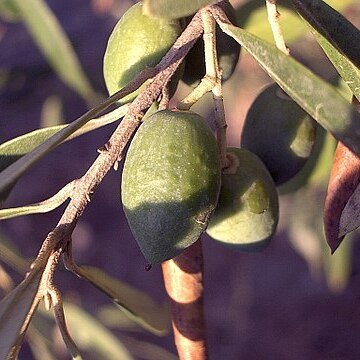Evergreen, small to medium-sized trees and shrubs. Shoots terete or quadrangular, often with lepidote scales. Lvs nearly always opposite, simple, coriaceous, entire, usually with lepidote scales at least when young. Fls many, small, ☿ or unisexual, usually in axillary panicles or racemes, not noticeably fragrant. Calyx deeply 4-lobed, very small. Corolla 4-lobed, subrotate; lobes > tube, ± valvate. Stamens 2, epipetalous, ± exserted; filaments short. Stigma sessile or subsessile, capitate or shortly 2-lobed. Fr. a 1-seeded, ovoid, ellipsoid or globose drupe.
Fls small, perfect or unisexual, us. panicled. Calyx 4-fid; corolla with short tube, 4 valvate lobes; stamens 2, filaments short. Ovary 2-loculed, style short, stigma 2-lobed or capitate; ovules 2 per locule; fr. a drupe. Trees or shrubs with opp., entire lvs. Genus of some 35 Old World spp. The N.Z. spp. are dioec.; fls in racemes, petals 0, stamens hypog.; stigma large, 2-lobed; mature drupe red, or occ. orange. They belong to section Gymnelaea (Spach Hist. Vég. Phan. 8, 1839, 258). O. apetala occurs in Norfolk Id, our other spp. are endemic.
Trees or shrubs, with simple, opposite, and generally entire leaves. Flowers small in axillary or terminal panicles, hermaphrodite, polygamous, or dioecious. Calyx truncate to 4-lobed. Corolla with a short tube, campanulate; with 4 induplicate-valvate, valvate, or slightly imbricate segments. Stamens 2, inserted by short filaments on the corolla tube. Ovary bilocular, usually 2 pendulous ovules in each loculus; style short, stigma more or less capitate. Fruit a drupe with a hard bony endocarp. Seeds typically solitary, endospermous.
Ovary subglobose, bilocular with 2 pendent ovules per loculus; style short, stigma capitate (obscurely biloped).
Corolla valvate, with very short tube and ovate petals, these not cucullate.
Leaves opposite and decussate, simple, often lepidote; acarodomatia absent.
Fruit a drupe with hard thick endocarp, usually 1–seeded.
Stamens 2, inserted on corolla tube; anthers introrse.
Flowers small, borne in paniculate cymes, 4–merous.
Trees and shrubs, often with very hard wood.
Seed containing endosperm.
Calyx lobes shallow.

